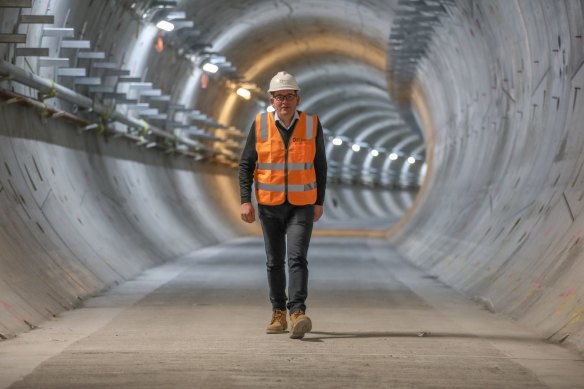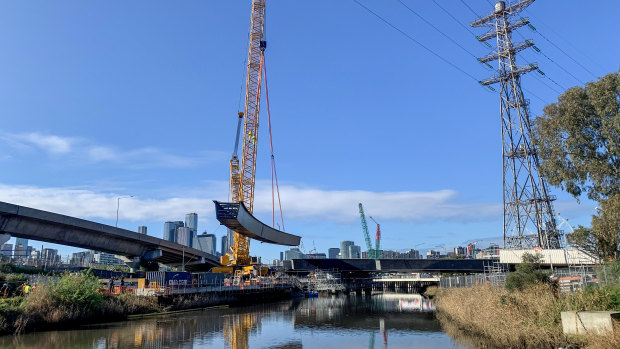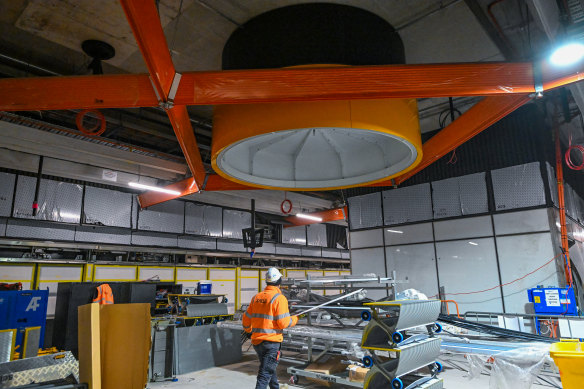
Save articles for later
Add articles to your saved list and come back to them any time.
Key points
- Eight days after winning the December 2014 election, Daniel Andrews halted work on the Coalition’s East West Link road tunnel (costing the state $1 billion) and launched his own infrastructure blitz to reshape Melbourne.
- The “Big Build” was central to his brand and political success but experts say its legacy is mixed, with city-changing Metro Tunnel sitting alongside massive new toll roads, the controversial $34.5 billion Suburban Rail Loop East, and a list of potentially more worthy projects that remain unbuilt.
Premier Daniel Andrews selected a test trip last week on the Metro Tunnel as the best experience of his nine years as premier.
It was a fitting way for the premier who did much to reshape Melbourne’s infrastructure to end his time in power.
Premier Daniel Andrews walks through the partially constructed Metro Tunnel in July.Credit: Getty Images
“I went from Arden and I travelled underneath the city at 80 kilometres an hour on a train that was made right here in Victoria through a tunnel that’s getting very close to being finished because of the good work of Victorians,” he said.
Travelling back to just eight days after winning the December 2014 election, Andrews made his first big building call by halting work on the Coalition’s East West Link road tunnel, costing the state $1 billion.
In its place and for the rest of his time at the helm he drove his own infrastructure blitz.
The “Big Build” was central to his brand and political success, but experts say its legacy is mixed, with the city-changing Metro Tunnel and the removal of 72 level crossings with another 38 to go, sitting alongside massive new toll roads, the controversial Suburban Rail Loop East, and a list of potentially more worthy projects that remain unbuilt.
And while Andrews’ project list is long, just as impressive is the scale of the blowouts he, Treasurer Tim Pallas and Transport and Infrastructure Minister Jacinta Allan have overseen.
In 2016, the North East Link was to cost “up to $10 billion”, but its price tag is now $16.5 billion. The West Gate Tunnel ballooned from $5.5 billion to $10 billion. The Metro Tunnel’s 2015 business case said it would cost $7.5 billion, but it will cost $12 billion. And the Suburban Rail Loop when announced was to cost $50 billion; its first stage alone, covering just a third of the total proposal, is budgeted at $34.5 billion.
Crystal Legacy, associate professor in urban planning at the University of Melbourne, said Andrews had left his mark on Melbourne, but questioned whether he built the right infrastructure for the state.
“He was very good at building infrastructure but not in a way that would deliver a more sustainable, equitable, resilient Melbourne,” she said.
A section of the West Gate tunnell at Moonee Ponds.Credit: Clay Lucas
West Gate Tunnel and North East Link
After cancelling the East West Link, Andrews then agreed in 2015 to a proposal by toll road giant Transurban to build a tunnel and elevated tollway linking the West Gate Freeway in Yarraville with CityLink at Docklands.
Along with its massive blowout, the project was meant to open this year but will not be finished until 2025. Early work is also under way on the North East Link toll road between Greensborough and Bulleen.
Rory Hyde, associate professor of architecture at the University of Melbourne said more toll roads and tunnels took us backwards.
“Every dollar we spend on roads takes us away from making a city that is really well served by public transport,” he said.
Legacy said these toll roads were significant in any assessment of Andrews’ legacy as the state grapples with car dependency and the climate change emergency.
Metro Tunnel
The Metro Tunnel creates a new rail line between South Kensington and South Yarra, joining the Cranbourne-Pakenham and Sunbury train lines with the capacity to move 12,000 commuters during the two-hour morning peak when it opens in 2025.
Construction under way on the Metro Tunnel. Credit: Joe Armao
Daniel Bowen, Public Transport Users Association spokesman said the project “was going nowhere fast” until Andrews came into office and was now nearing completion.
“Some governments spend up big on roads and ignore public transport, but that hasn’t been the case under Daniel Andrews,” he said.
Suburban Rail Loop
Andrews announced the Suburban Rail Loop in 2018 as a 90-kilometre loop encircling Melbourne. But work has only started on the eastern leg between Cheltenham and Box Hill, due to open in 2035. Labor has said it will be up to future governments to decide if they build the rest.
Transport experts have questioned the project’s merits and Legacy said the most disappointing aspect was that it started in the east.
“It should start in the west where there is clear transport infrastructure deficits as well as a growing community that needs to be served,” she said.
Melbourne’s long-awaited Airport Rail Link was put on ice earlier this year, and rapidly growing western suburbs communities have been up in arms over the lack of progress delivering other improved train services promised as part of the Andrews’ “Western Rail Plan”.
Not built
Michael Buxton, emeritus professor of environment and planning at RMIT, said Andrews had the right intent, but built the wrong projects.
“He was able to make his name as a man of action but unfortunately, it was the wrong kind of action,” Buxton said. “He should have built the Melbourne Metro 2 (a second rail tunnel under the CBD) better linking the suburbs and get better public transport to the outer suburbs.
”As the Catholics say the road to hell is paved with good intentions.”
Jonathon Marsden, chair of the Metropolitan Transport Forum, said while Andrews had the courage to spend big on city-shaping transport infrastructure it was at the expense of other projects.
“A lot is left undone – key projects such as Airport Rail, the Western Rail Plan and fast rail to Geelong have been priced out by big gambles on hugely expensive mega-projects such as the Suburban Rail Loop,” he said.
Victoria was required under the Disability Discrimination Act to upgrade all Melbourne’s tram stop to be accessible by the end of 2022. But only 82 stops were built during Andrews’ nine years in power, leaving around 1200 inaccessible stops across the city.
”The accessible tram deadline came and went last year and is urgently needed,” Marsden said. “Straightened out bus routes and joined-up walking and riding paths are yet to be given the focus that is needed to make Melbourne truly liveable. The next premier must refocus on these pressing needs.”
The Morning Edition newsletter is our guide to the day’s most important and interesting stories, analysis and insights. Sign up here.
Most Viewed in Politics
From our partners
Source: Read Full Article


